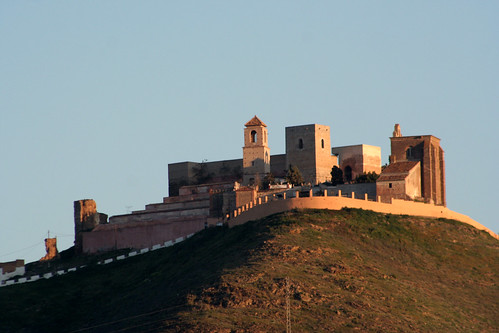In between 1587 and 1593 Alora was home to the fabled Cervantes and in 1628 Alora gained independence from Málaga. Alora is said to be the birthplace of Malagueño flamenco. A visit to the village, which consists of a series of very steep slopes and attractive cobbled streets, is well worthwhile. The whitewashed streets are lined with lemon trees and converge on a square on the lowest level, overlooked by a the impressive seventeenth century church of La Encarnación which was built during the Catholic era of rule on the site of a former mosque.
From the square, climb to the castle on foot, or go by car, to the cemetery from where you can enjoy the splendid panorama of the Guadalhorce river basin.
(http://www.andalucia.com/province/malaga/alora/home.htm)
In Roman times, it was known as Iluro, while the Arabs called it Alura.
Alora was an important Roman town between 81 and 96 A.D., as proved by the archaeological remains found here pertaining to the period, particularly a monolith from the time of the emperor Domicianus, on which the words "Municipium Iluritanum" can be read. Today it stands in the patio of the parish church. The town, linked to the Roman region of Betica, was, according to the historian Columela, an important trading centre of wheat, barley, honey, wine and oil. All these products could be easily obtained from the area’s land and its prosperity was such that Alora even minted its own coins.
It was conquered by the Vandals in the 5th century. Remains from the Visigoth period can be found in the fortress located atop Las Torres mount.
During the Moslem occupation, the Christian kings besieged the town on numerous occasions due to its privileged strategic location (the castle overlooks the whole Malaga basin). Alfonso VIII attacked it in 1184, Alfonso XI in 1319. Later, John II, 1434, and Enrique IV, 1455 also tried to conquer the town. Due to its proximity to Bobastro, where the muladi (Christian converted to Islam) chief Omar Ben Hafsun gathered his forces, the town must also have played a key role in the 11th-century rebellion against the Caliphate of Cordoba. Its reputation as an impregnable fortress gave rise to one of the most beautiful frontier ballads: the Ballad of Alora, which refers to the town as “the well besieged" and which can be seen reproduced on a tablet embedded in the castle walls.
The town finally fell into Christian hands on 10 June 1484. The attacking troops, who bore the banner of the Catholic Monarchs, were led by Captain Don Luis Fernandez Portocarrero.
After the Christian conquest, the town’s inhabitants continued to live inside the fortress, and the original parish church, now the cemetery chapel, was built on the foundations of a former mosque. With the passage of time, the town began to spread to the foot of the hill.
A decree issued by Philip IV in 1628 saw Alora cease to belong to the city of Malaga "for evermore", according to the exact wording of the document.
An earthquake left the original church in ruins in 1680 and destroyed the older districts of the town.
The Castle, witness to so many deaths in attempts to capture and defend it, later became the town cemetery.
-El castillo de Álora fue el primero construido por los fenicios y posteriormente ampliado por los Romanos. En el quinto centenario del castillo, fue destruido por los Visigodos, solo lo reconstruyeron los Moros; todavía existen los restos de esta era, a saber, los restos la puerta de acero decorada y el tradicional mirador Árabe.

- Entre 1587 y 1593 Álora fue la casa del fabuloso Cervantes y en 1628 Álora se ganó la independencia de Málaga. Se dice que Álora es el nacimiento del flamenco Malagueño. Si visitas la ciudad, consiste en una serie de cuestas empinadas y atractivas calles. Las calles están encaladas y bordeadas con limoneros; convergen en una plaza en el nivel más bajo. Allí predomina una iglesia del siglo XVII, la Iglesia de la Encarnación, que fue construida en tiempos de los Reyes Católicos en el lugar de una antigua mezquita. Desde la plaza, se puede subir al castillo a pie o ir en coche, hasta el cementerio, desde donde podrá disfrutar del espléndido panorama de la cuenca del río Guadalhorce.
-En tiempos de Roma, era conocida como Iluro, mientras que los árabes la llamaron Alura.
Álora fue una importante ciudad romana entre 81 y 96 dC, como lo demuestran los restos arqueológicos encontrados aquí en relación con este período, en particular un monolito de la época del emperador Domiciano, en el que las palabras "Municipium Iluritanum" se pueden leer. Hoy en día, se encuentra en el patio de la iglesia parroquial. La ciudad, vinculada a la región romana de la Bética, era, según el historiador Columela, un importante centro de comercio de trigo, cebada, miel, vino y aceite. Todos estos productos pueden ser fácilmente obtenidos de tierras de la zona y su prosperidad era tal que incluso Álora acuñaba sus propias monedas.
-Fue conquistada por los vándalos en el siglo 5 º. Los restos de la época visigoda se pueden encontrar en la fortaleza situada en lo alto de Las Torres de montaje.
Publicado por Ana y Anabel.















No hay comentarios:
Publicar un comentario